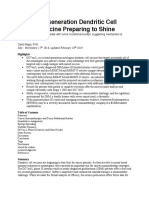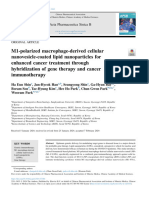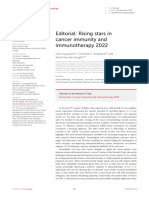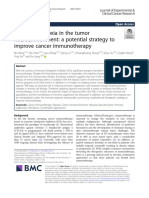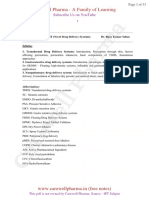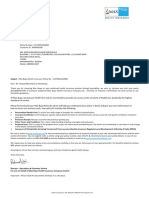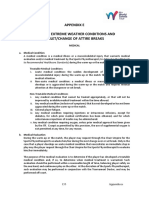Fimmu 11 00139
Fimmu 11 00139
Uploaded by
carlosCopyright:
Available Formats
Fimmu 11 00139
Fimmu 11 00139
Uploaded by
carlosOriginal Title
Copyright
Available Formats
Share this document
Did you find this document useful?
Is this content inappropriate?
Copyright:
Available Formats
Fimmu 11 00139
Fimmu 11 00139
Uploaded by
carlosCopyright:
Available Formats
EDITORIAL
published: 11 February 2020
doi: 10.3389/fimmu.2020.00139
Editorial: The Role of Complement in
Tumors
Barbara E. Rolfe 1*, Ruben Pio 2 , Trent M. Woodruff 3 , Maciej M. Markiewski 4 and
Helga D. Manthey 1
1
Australian Institute for Bioengineering and Nanotechnology, The University of Queensland, Brisbane, QLD, Australia,
2
Center for Applied Medical Research (CIMA), University of Navarra, Pamplona, Spain, 3 School of Biomedical Sciences, The
University of Queensland, Brisbane, QLD, Australia, 4 Department of Immunotherapeutics and Biotechnology, School of
Pharmacy, Texas Tech University Health Sciences Center, Abilene, TX, United States
Keywords: complement, cancer, metastasis, C5b-9, C1q, C3a, C5a, complement regulatory proteins
Editorial on the Research Topic
The Role of Complement in Tumors
Activation of the complement system is one of the earliest responses to invading pathogens and
tissue damage (1). Complement activation leads to production of a range of effectors including the
opsonin C3b, the anaphylatoxins C3a and C5a, and the C5b-9 complex (membrane attack complex;
MAC) (2, 3). In addition to potent innate immune activities, complement effector systems also
contribute to efficient adaptive immune responses (4). While critical to proper immune function,
inappropriate or excessive complement activation contributes to many pathological inflammatory
conditions (5), including cancer. As described in this issue, the complement system is increasingly
recognized as a double-edged sword: on the one hand contributing to the anti-tumor response, but
Edited and reviewed by: on the other protecting the tumor against immune attack and promoting metastasis.
Catherine Sautes-Fridman,
INSERM U1138 Centre de Recherche
des Cordeliers, France COMPLEMENT-DEPENDENT CYTOTOXICITY AND C5b-9
*Correspondence: (MEMBRANE ATTACK COMPLEX)
Barbara E. Rolfe
b.rolfe@uq.edu.au As described by Macor et al., the complement system has long been recognized to contribute to
anti-tumor defense mechanisms via complement dependent cytotoxicity (CDC) (6) and antibody-
Specialty section: dependent cell mediated cytotoxicity (ADCC) (7). The introduction of recombinant antibodies
This article was submitted to for cancer treatment has led to renewed interest in complement as an anti-tumor defense system.
Cancer Immunity and Immunotherapy, The protective role of complement in cancer is discussed, with focus on the beneficial effect of
a section of the journal
complement-fixing antibodies which initiate cancer cell killing via CDC.
Frontiers in Immunology
The cytotoxic activities of C5b-9, and the mechanisms by which it damages cancer cells, are
Received: 14 January 2020 further discussed by Fishelson and Kirschfink, along with the multiple mechanisms that tumor
Accepted: 20 January 2020
cells employ to resist C5b-9-induced death. They discuss the potential for therapeutic approaches
Published: 11 February 2020
to counter tumor escape mechanisms and potentiate antibody-based immunotherapies, but caution
Citation: that intervention strategies to augment complement activation could also worsen outcomes.
Rolfe BE, Pio R, Woodruff TM,
Although C5b-9 has traditionally been attributed an anti-tumoral role through CDC, Vlaicu
Markiewski MM and Manthey HD
(2020) Editorial: The Role of
et al. review the evidence that C5b-9 at a sub-lytic dose stimulates tumor growth. Hence
Complement in Tumors. strategies to counteract the tumor-promoting traits of C5b-9 and potentiate anti-tumoral actions
Front. Immunol. 11:139. (including enhanced efficacy of antibody-based immunotherapy) may be the next major direction
doi: 10.3389/fimmu.2020.00139 for immuno-oncology.
Frontiers in Immunology | www.frontiersin.org 1 February 2020 | Volume 11 | Article 139
Rolfe et al. Editorial: The Role of Complement in Tumors
COMPLEMENT REGULATORY PROTEINS responses, but is also crucial to metastasis, endowing tumor
cells with properties required for metastatic dissemination and
As described by Geller and Yan, membrane and soluble establishment. Complement activation products (primarily C3a
complement regulatory proteins (CRPs) prevent excessive and C5a) induce a range of mediators which promote epithelial-
complement activation. Therefore, over-expression of CRPs by mesenchymal transition, tumor growth, invasion, dissemination
tumor cells protects them against complement-mediated attack, via lymphatic and circulatory systems, and also protect cells
interferes with anti-tumor therapies, and enhances metastatic within the metastatic niche. The authors highlight the potential
potential. The application of CRPs as prognostic biomarkers of complement-targeting drugs to augment the clinical efficacy of
and therapeutic targets is discussed, along with the potential for current immunotherapies and effectively eradicate both primary
combinatorial approaches with other anti-tumor therapies. tumors and distant metastases.
COMPLEMENT C1q CONCLUSIONS
The first subcomponent of the classical complement pathway, Despite recent clinical advances in cancer immunotherapy,
C1q is a pattern recognition molecule locally synthesized by the estimated percentage of patients responding to checkpoint
macrophages and dendritic cells (8). Bioinformatics analysis by inhibitors in the United States in 2018 was only 12.46% (11).
Mangogna et al. suggests C1q as a new prognostic biomarker for Hence there remains an urgent need for novel therapeutic
several cancers. strategies to boost response rates. As a critical link between
the innate and adaptive immune systems, the complement
ANAPHYLATOXINS C3a AND C5a system is a promising therapeutic target. However, knowledge
is the key to realizing the clinical potential of complement-
Since the seminal paper of Markiewski et al. (9) identifying a targeting therapeutics. Only a thorough understanding of the
role for C5a in promoting tumor progression, similar effects role of complement pathways in the tumor microenvironment
have been demonstrated in a range of murine cancer models. will enable development of strategies to selectively (and
Wang et al. propose C3aR and C5aR1 as a new class of safely) target the pro-tumor effects of complement, while
immune checkpoints. They discuss findings suggesting that simultaneously augmenting the anti-tumor effects. To quote
C3aR/C5aR signaling regulates T cell mediated antitumor Fishelson and Kirschfink, “currently we perceive only the
immunity via transcriptional suppression of interleukin (IL)- tip of the ice-berg of . . . interactions between cancer cells
10. Given resistance of the majority of patients to the current and complement components.” Indeed, given the diversity of
forms of immunotherapy, and adverse reactions associated with responses, therapeutic protocols will likely need to be optimized
these approaches, the authors suggest the manipulation of the for each cancer type and stage, and possibly for individual cancer
C3aR/C5aR/IL-10 pathway as an alternative strategy for cancer. patients, depending on their “immune history.”
Lenkiewicz et al. discovered that C3 and C5 cleavage
fragments enhance trafficking, motility and, therefore, AUTHOR CONTRIBUTIONS
dissemination of malignant cells in hematologic malignancies
through a p38 MAPK and inducible heme oxygenase 1 All authors contributed to the conception and design of this
(HO-1) manner. They propose that activation of the work. BR drafted the manuscript, the other editors RP, TW,
complement cascade in patients with these malignancies (e.g., MM, and HM provided critical revisions and approved the
triggered by infection) can contribute to faster dissemination submitted manuscript.
of disease. Thus, targeting this pathway may ameliorate
dissemination of leukemic cells and improve clinical outcomes in FUNDING
these patients.
Kleczko et al. discuss the potential for complement BR, RP, TW, and HM acknowledge support from grants
targeting therapies for the treatment of intractable cancers, from the Australian National Health and Medical Research
in particular lung cancer. They review the mechanisms by Council (NHMRC; APP1103951 and APP1164202) and Cancer
which the anaphylatoxins C3a and C5a influence tumor growth Council Queensland (CCQ). RP was supported by the AECC
and promote epithelial-mesenchymal transition and tumor Scientific Foundation, and Fondo de Investigación Sanitaria-
metastasis. Since complement proteins can regulate both pro- Fondo Europeo de Desarrollo Regional Una manera de hacer
and anti-tumorigenic pathways, the authors stress the need to Europa (PI17/00411) and MM by the National Institute of
better understand the effects of complement activation within Health (R01CA190209).
tumor tissue, and how this may be influenced by different
oncogenic drivers. ACKNOWLEDGMENTS
Cancer metastasis is estimated to be responsible for greater
than 90% of cancer deaths (10). As discussed by Ajona We thank all the authors for their contributions to this Research
et al., distorted complement homeostasis not only remodels Topic. We also thank the reviewers for their evaluation of
the tumor microenvironment by inhibiting anti-tumor immune the manuscripts.
Frontiers in Immunology | www.frontiersin.org 2 February 2020 | Volume 11 | Article 139
Rolfe et al. Editorial: The Role of Complement in Tumors
REFERENCES 9. Markiewski MM, DeAngelis RA, Benencia F, Ricklin-Lichtsteiner SK,
Koutoulaki A, Gerard C, et al. Modulation of the antitumor immune
1. Kolev M, Kemper C. Keeping it all going-complement meets metabolism. response by complement. Nat Immunol. (2008) 9:1225–35. doi: 10.1038/
Front Immunol. (2017) 8:1. doi: 10.3389/fimmu.2017.00001 ni.1655
2. Merle NS, Church SE, Fremeaux-Bacchi V, Roumenina LT. Complement 10. Chaffer CL, Weinberg RA. A perspective on cancer cell
system part I - Molecular mechanisms of activation and regulation. Front metastasis. Science. (2011) 331:1559–64. doi: 10.1126/science.12
Immunol. (2015) 6:262. doi: 10.3389/fimmu.2015.00262 03543
3. Merle NS, Noe R, Halbwachs-Mecarelli L, Fremeaux-Bacchi V, Roumenina 11. Haslam A, Prasad V. Estimation of the percentage of US
LT. Complement system part II: role in immunity. Front Immunol. (2015) patients with cancer who are eligible for and respond to
6:257. doi: 10.3389/fimmu.2015.00257 checkpoint inhibitor immunotherapy drugs. JAMA Netw
4. Clarke EV, Tenner AJ. Complement modulation of T cell immune Open. (2019) 2:e192535. doi: 10.1001/jamanetworkopen.201
responses during homeostasis and disease. J Leukoc Biol. (2014) 96:745–56. 9.2535
doi: 10.1189/jlb.3MR0214-109R
5. Hawksworth OA, Li XX, Coulthard LG, Wolvetang EJ, Woodruff TM. New Conflict of Interest: The authors declare that the research was conducted in the
concepts on the therapeutic control of complement anaphylatoxin receptors. absence of any commercial or financial relationships that could be construed as a
Mol Immunol. (2017) 89:36–43. doi: 10.1016/j.molimm.2017.05.015 potential conflict of interest.
6. Ostrand-Rosenberg S. Cancer and complement. Nat Biotechnol. (2008)
26:1348–9. doi: 10.1038/nbt1208-1348 Copyright © 2020 Rolfe, Pio, Woodruff, Markiewski and Manthey. This is an open-
7. Gelderman KA, Tomlinson S, Ross GD, Gorter A. Complement function in access article distributed under the terms of the Creative Commons Attribution
mAb-mediated cancer immunotherapy. Trends Immunol. (2004) 25:158–64. License (CC BY). The use, distribution or reproduction in other forums is permitted,
doi: 10.1016/j.it.2004.01.008 provided the original author(s) and the copyright owner(s) are credited and that the
8. Thielens NM, Tedesco F, Bohlson SS, Gaboriaud C, Tenner AJ. C1q: original publication in this journal is cited, in accordance with accepted academic
a fresh look upon an old molecule. Mol Immunol. (2017) 89:73–83. practice. No use, distribution or reproduction is permitted which does not comply
doi: 10.1016/j.molimm.2017.05.025 with these terms.
Frontiers in Immunology | www.frontiersin.org 3 February 2020 | Volume 11 | Article 139
You might also like
- Health Promotion and Disease Prevention in Clinical Practice 2Document1,117 pagesHealth Promotion and Disease Prevention in Clinical Practice 2Matthew Zane BroderickNo ratings yet
- Ziva Meditation Ebook PDFDocument33 pagesZiva Meditation Ebook PDFLacramioara Ionescu100% (3)
- A Second-Generation Dendritic Cell Cancer Vaccine Preparing To ShineDocument19 pagesA Second-Generation Dendritic Cell Cancer Vaccine Preparing To Shinebiggercapital100% (5)
- Temple Grandin - Movie AnalysisDocument5 pagesTemple Grandin - Movie AnalysisMrinmayee KorgaonkarNo ratings yet
- Immunotherapy and Radiotherapy in Melanoma A Multidisciplinary Comprehensive ReviewDocument9 pagesImmunotherapy and Radiotherapy in Melanoma A Multidisciplinary Comprehensive ReviewLetizia De LucaNo ratings yet
- Fimmu 13 974912Document12 pagesFimmu 13 974912Ego-free New-earthNo ratings yet
- (2024) Acta Pharmaceutica Sinica B. M1-Polarized Macrophage-Derived CellularDocument15 pages(2024) Acta Pharmaceutica Sinica B. M1-Polarized Macrophage-Derived CellularsleeepyknotNo ratings yet
- Harnessing Bene Fit From Targeting Tumor Associated Carbohydrate AntigensDocument9 pagesHarnessing Bene Fit From Targeting Tumor Associated Carbohydrate Antigensspin_echoNo ratings yet
- 2016 Fasting Boosts Sensitivity of Human Skin Melanoma To Cisplatin - Induced Cell DeathDocument7 pages2016 Fasting Boosts Sensitivity of Human Skin Melanoma To Cisplatin - Induced Cell DeathKarin HerreraNo ratings yet
- 1 s2.0 S1818087623000235 MainDocument13 pages1 s2.0 S1818087623000235 MainMeisya NurmentariNo ratings yet
- Treatment of Cancer ResearchDocument16 pagesTreatment of Cancer ResearchKomal SharmaNo ratings yet
- Resistance in Prostate CancerDocument16 pagesResistance in Prostate CancerMohammed AlabdullahNo ratings yet
- Nanoparticles in Tumor Microenvironment Remodeling and Cancer ImmunotherapyDocument48 pagesNanoparticles in Tumor Microenvironment Remodeling and Cancer Immunotherapylingling.zhangwangNo ratings yet
- Fimmu 14 1326374Document3 pagesFimmu 14 1326374Maria PopescuNo ratings yet
- 2022 01 07 475451v1 FullDocument35 pages2022 01 07 475451v1 Fulljongsu kimNo ratings yet
- Fimmu 11 577869Document18 pagesFimmu 11 577869nataliaNo ratings yet
- Reprogramming The Tumour Microenvironment by RadioDocument12 pagesReprogramming The Tumour Microenvironment by RadioCarlos N. Rojas PuyolNo ratings yet
- Cisplatin-Resistant A549 Non-Small Cell Lung Cancer Cells Can Be Identified by Increased Mitochondrial Mass and Are Sensitive To Pemetrexed TreatmentDocument14 pagesCisplatin-Resistant A549 Non-Small Cell Lung Cancer Cells Can Be Identified by Increased Mitochondrial Mass and Are Sensitive To Pemetrexed Treatment高燕云No ratings yet
- Molecular Carcinogenesis - 2023 - Shameem - Mitochondria Targeted Metformin Mitomet Inhibits Lung Cancer in CellularDocument11 pagesMolecular Carcinogenesis - 2023 - Shameem - Mitochondria Targeted Metformin Mitomet Inhibits Lung Cancer in CellularNour elsayedNo ratings yet
- Fimmu 13 961805Document22 pagesFimmu 13 961805adila zafrullahNo ratings yet
- Drake 2006Document3 pagesDrake 2006Ruben NatarîșNo ratings yet
- Advances in Cancer Immunotherapy 2019 - Latest TrendsDocument21 pagesAdvances in Cancer Immunotherapy 2019 - Latest TrendsSWAGATIKA CHANDANo ratings yet
- Cancers 15 03408 v2Document14 pagesCancers 15 03408 v2Jesus Barraza SánchezNo ratings yet
- Cancer ModellingDocument15 pagesCancer ModellingAzza Ahmed100% (1)
- IJN 30726 Liposomes and Nanotechnology in Drug Development Focus On o - 091312 PDFDocument9 pagesIJN 30726 Liposomes and Nanotechnology in Drug Development Focus On o - 091312 PDFnayazzNo ratings yet
- CAFs and Cancer 2019Document15 pagesCAFs and Cancer 2019Kudelko MatNo ratings yet
- Ciardiello2019 PDFDocument11 pagesCiardiello2019 PDFVHINTA FADILA ERZANo ratings yet
- Perrino 2014Document11 pagesPerrino 2014meltastNo ratings yet
- MDPs AnticancerDocument36 pagesMDPs AnticancerMihaela DochiaNo ratings yet
- Resistence To ChemioDocument13 pagesResistence To ChemioOscarGagliardiNo ratings yet
- The Role of Immunotherapy in ALL and Its Impact On HealthcareDocument5 pagesThe Role of Immunotherapy in ALL and Its Impact On HealthcareInternational Journal of Innovative Science and Research TechnologyNo ratings yet
- Rivas 2021 DrugDocument19 pagesRivas 2021 DrugSusovon ChowdhuryNo ratings yet
- Pembrolizumab For Advanced Cervical Cancer Safety and EfficacyDocument9 pagesPembrolizumab For Advanced Cervical Cancer Safety and EfficacyluizaNo ratings yet
- Specific Targetin of CD163 + TAM in Tumor JEM 2019Document18 pagesSpecific Targetin of CD163 + TAM in Tumor JEM 2019Kudelko MatNo ratings yet
- mRNA Vaccine For Cancer Immunotherapy: Review Open AccessDocument23 pagesmRNA Vaccine For Cancer Immunotherapy: Review Open Accesszainab.a.m.bualiNo ratings yet
- Fimmu 13 947648Document13 pagesFimmu 13 947648Caio SilveiraNo ratings yet
- Targeting Hypoxia in The Tumor Microenvironment ADocument16 pagesTargeting Hypoxia in The Tumor Microenvironment AViviana OrellanaNo ratings yet
- Prophylactic Dendritic Cell-Based Vaccines Efficiently Inhibit Metastases in Murine Metastatic MelanomaDocument21 pagesProphylactic Dendritic Cell-Based Vaccines Efficiently Inhibit Metastases in Murine Metastatic MelanomaTatiane RibeiroNo ratings yet
- Combining Silencing and Entinostat Therapy To Overcome Resistance To Cancer Immunotherapy in NeuroblastomaDocument18 pagesCombining Silencing and Entinostat Therapy To Overcome Resistance To Cancer Immunotherapy in NeuroblastomaVăn PhúNo ratings yet
- Cancer TextDocument8 pagesCancer Textvictor9419No ratings yet
- ModificacionesDocument7 pagesModificacionesKatia KuchikiNo ratings yet
- Fonc 09 00396Document8 pagesFonc 09 00396asdffdsaNo ratings yet
- Molecules: A Review On Cancer Immunotherapy and Applications of Nanotechnology To Chemoimmunotherapy of Different CancersDocument24 pagesMolecules: A Review On Cancer Immunotherapy and Applications of Nanotechnology To Chemoimmunotherapy of Different CancersJuan Vera SanchezNo ratings yet
- Immunotherapy in Uterine Cancers: January 2011Document9 pagesImmunotherapy in Uterine Cancers: January 2011Nurul Ulya RahimNo ratings yet
- 1 s2.0 S2452199X21001092 MainDocument25 pages1 s2.0 S2452199X21001092 MainKamille VitóriaNo ratings yet
- Ijms 23 09617Document3 pagesIjms 23 09617vwjpksbrNo ratings yet
- Exosome-Based Immunotherapy: A Promising Approach For Cancer TreatmentDocument16 pagesExosome-Based Immunotherapy: A Promising Approach For Cancer Treatment1810 15Marvin LionelNo ratings yet
- Nihms 1727218Document27 pagesNihms 1727218yaacoubsergeNo ratings yet
- Cancer Immunology and ImmunotherapyDocument15 pagesCancer Immunology and ImmunotherapyRamona PalalogosNo ratings yet
- Fimmu 14 1140541Document11 pagesFimmu 14 1140541Wang JianweiNo ratings yet
- Advances in Cancer Immunotherapy 2019 - Latest TrendsDocument11 pagesAdvances in Cancer Immunotherapy 2019 - Latest TrendsJuan Sebastian SolanoNo ratings yet
- Cancer Vaccines Recent Insights and Future DirectionsDocument16 pagesCancer Vaccines Recent Insights and Future DirectionsVirginia LoukaNo ratings yet
- Cross-Species Single-Cell Analysis of Pancreatic Ductal Adenocarcinoma Reveals Antigen-Presenting Cancer-Associated FibroblastsDocument23 pagesCross-Species Single-Cell Analysis of Pancreatic Ductal Adenocarcinoma Reveals Antigen-Presenting Cancer-Associated FibroblastsHao LiuNo ratings yet
- CancersDocument19 pagesCancerssidi.baoNo ratings yet
- 18 JL 7Document15 pages18 JL 7Irma SihotangNo ratings yet
- Anticancer 2Document21 pagesAnticancer 2maryampharmacist13No ratings yet
- Marzagalli 2019Document15 pagesMarzagalli 2019Wojciech WawrętyNo ratings yet
- Edbk 237967Document15 pagesEdbk 237967SYED MAAZ TARIQ100% (1)
- Antibiotics For Cancer Treatment: A Double-Edged SwordDocument15 pagesAntibiotics For Cancer Treatment: A Double-Edged SwordRushikesh G ParitNo ratings yet
- Bottero2017 Artigo Científico Oncologia ImunoterapiaDocument27 pagesBottero2017 Artigo Científico Oncologia Imunoterapiacarolinan743No ratings yet
- Cellular and Molecular Players in The Tumor Microenvironment of Renal Cell CarcinomaDocument16 pagesCellular and Molecular Players in The Tumor Microenvironment of Renal Cell CarcinomaLuis Javier Vera ZamoraNo ratings yet
- fimmu-12-652160Document24 pagesfimmu-12-652160BooksnugNo ratings yet
- Immunotherapy in Translational Cancer ResearchFrom EverandImmunotherapy in Translational Cancer ResearchLaurence J. N. CooperNo ratings yet
- He Married A Sociopath. Me. - The New York TimesDocument3 pagesHe Married A Sociopath. Me. - The New York TimesRobert CaballeroNo ratings yet
- RLE Handwashing and GlovingDocument3 pagesRLE Handwashing and Glovingnavalesmay1No ratings yet
- Unit 1 Public Health: Definition and Concept: Dr. Rajesh Agrawal Associate Professor, MBICEMDocument15 pagesUnit 1 Public Health: Definition and Concept: Dr. Rajesh Agrawal Associate Professor, MBICEMshrutiNo ratings yet
- ESPEN Practical Guideline Nutritional Support For Polymorbid Medical InpatientsDocument18 pagesESPEN Practical Guideline Nutritional Support For Polymorbid Medical InpatientscostarlrafaelaNo ratings yet
- 2001 Mart Üds Sağlik Bi̇li̇mleri̇Document20 pages2001 Mart Üds Sağlik Bi̇li̇mleri̇bandrollNo ratings yet
- Food Safety at HomeDocument2 pagesFood Safety at HomeChristopher MillerNo ratings yet
- 1980 Otto. A Comparative Analysis of Intrusion of Incisor Teeth Achieved in Adults and Children According To Facial TypeDocument10 pages1980 Otto. A Comparative Analysis of Intrusion of Incisor Teeth Achieved in Adults and Children According To Facial TypeSEBASTIAN ANDRES MIRANDA GONZALEZNo ratings yet
- Đề 11Document5 pagesĐề 11John SnowdenNo ratings yet
- Hiking and TrekkingDocument14 pagesHiking and TrekkingrkNo ratings yet
- New BabyDocument844 pagesNew Babysamar.z.hamdanNo ratings yet
- PlasmodiumFalciparum New InformationDocument3 pagesPlasmodiumFalciparum New InformationJustin Jim SalazarNo ratings yet
- Music and Health June 2020utasv PDFDocument4 pagesMusic and Health June 2020utasv PDFPayneOgden54No ratings yet
- UntitledDocument2 pagesUntitledAdrianne FloresNo ratings yet
- Unit 3, Novel Drug Delivery Systems, B Pharmacy 7th Sem, Carewell PharmaDocument33 pagesUnit 3, Novel Drug Delivery Systems, B Pharmacy 7th Sem, Carewell Pharmaayush pathak100% (1)
- Medicare Health Risk AssessmentDocument5 pagesMedicare Health Risk AssessmentJamie LittleNo ratings yet
- 194102-Article Text-491467-1-10-20200403Document6 pages194102-Article Text-491467-1-10-20200403mufcharovaNo ratings yet
- Pre-Thesis (On Alcohol)Document6 pagesPre-Thesis (On Alcohol)Vlad Lipsam0% (1)
- Allergic Rhinitis & Vasomotor Rhinitis: Dr. Ritesh Mahajan ENT Consultant GMC, KathuaDocument70 pagesAllergic Rhinitis & Vasomotor Rhinitis: Dr. Ritesh Mahajan ENT Consultant GMC, Kathuamanoj kumarNo ratings yet
- E-Palaro-Form-2018-2020 (1) TAMADocument257 pagesE-Palaro-Form-2018-2020 (1) TAMALadyAngelIgnacioValgunaNo ratings yet
- Efsa PDFDocument277 pagesEfsa PDFDany DidiNo ratings yet
- Memory Reconsolidation: Cristina M. Alberini and Joseph E. LedouxDocument5 pagesMemory Reconsolidation: Cristina M. Alberini and Joseph E. LedouxFelipe P. SilvaNo ratings yet
- Hybridization in Contemporary Latvian Literature: August 2016Document29 pagesHybridization in Contemporary Latvian Literature: August 2016Bogdan SoptereanNo ratings yet
- Download Full Larone s medically important fungi a guide to identification 6th Edition Randall T. Hayden PDF All ChaptersDocument52 pagesDownload Full Larone s medically important fungi a guide to identification 6th Edition Randall T. Hayden PDF All Chaptersbyxbeshoun6q100% (2)
- Max Existing 20 21Document36 pagesMax Existing 20 21karan mehtaNo ratings yet
- 2023-Itf-World-Tennis-Tour-Regulations APPENDIX EDocument8 pages2023-Itf-World-Tennis-Tour-Regulations APPENDIX EandyNo ratings yet
- Don Honorio Ventura State University: Dhvsu Mexico CampusDocument5 pagesDon Honorio Ventura State University: Dhvsu Mexico CampusPrincess DungoNo ratings yet
- Chapter 2 Pychoanalytic Play TherapyDocument57 pagesChapter 2 Pychoanalytic Play TherapyJeffrey ManzanoNo ratings yet


